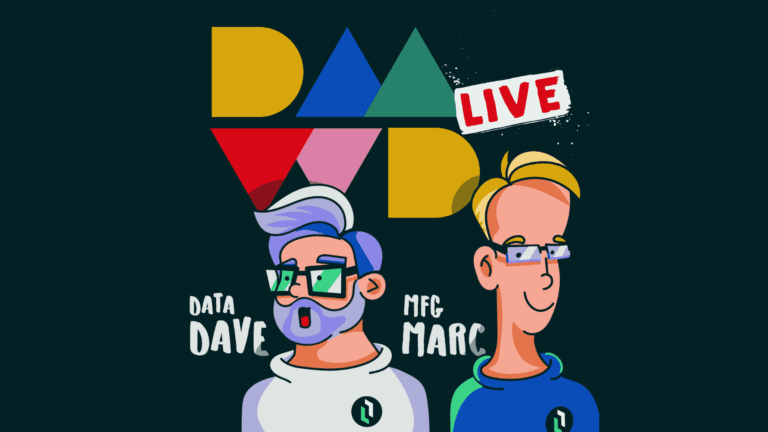Vishvesh Shah
Director of Product Management
The integration of edge computing with digital twins can help address challenges faced by manufacturers. It can reduce response time, optimize data, improve security, and lower risk.
Wondering whether the legacy systems of record can be augmented to meet the demands of tomorrow’s goals?

We’ve put together the top three must-have tips for taking legacy systems of record to the next level. Our team of experts, “Data Dave” McMorran, Litmus Sales Engineer, “Manufacturing Marc” Dekker, Vice President of Customer Success, and Dave Griffith, host of Manufacturing Hub podcast and Industry 4.0 expert, bring together their best guidance.
This blog is an excerpt from the candid conversation from Do More with Data Live, the Industry 4.0 jargon-free videocast show on how to do more with data.
The discussions shed light on the complexities of working with “Industry 3.x” hardware and the strategies needed to harness valuable data for continuous improvement. Here’s a quick review of the discussion and why you should take a minute to check out the full videocast.
For today’s manufacturers, the prevalence of legacy hardware with solutions like Rockwell Allen Bradley PLC 5, Slick 500, and others are still the systems of choice for running manufacturing plants. There is often a reluctance to upgrade due to perceived risks and the belief that “if it’s working fine, just keep it going.”
Our team discussed the practical challenges associated with upgrading or replacing legacy systems. Rather than advocating for a wholesale replacement, the Do More with Data experts emphasize the importance of working with what is already in place so that operations continue.
“Recognizing that SCADA, MES, and historians are often independent and purpose-fit for one specific thing, manufacturers should think about adding additional functions to existing systems. Integrate sensors or deploy edge devices to collect necessary data without disrupting existing operations,” said Dave McMorran.
In addition to this approach, look for ways to add context to data by investigating newer data operations systems that can bring together these “data pockets” to connect and give context to disparate data for insights and decisions.
McKinsey reports IIoT implementations help to increase productivity by up to 90 percent, reduce machine downtime by 50 percent, and reduce maintenance costs by up to 40 percent. Manufacturers should start digital transformation projects to augment their legacy systems with a focus on how to deliver significant improvement and return on investment.
“Legacy systems can be described as technology solutions but oftentimes, they are processes too,” said Marc Dekker. “Innovating on top of legacy systems requires that manufacturers look at ways to move beyond an Excel spreadsheet or clipboard with maintenance schedules.”
To understand all the systems and processes that might need to change, the team recommended tapping into the expertise of the front-line teams to understand how the data should flow and the current limitations of legacy systems. The front-line workforce, data scientists, and business group together can provide valuable intel to understand the systems and data sources that should be considered in transformation projects and the pitfalls with current legacy systems.
“The engineers on the OT side that have been doing this for 30 years are used to storing data and a historian or tag name value and timestamp aren’t sure how to modify that practice with a new technology,” said Dave McMorran.
A cultural mind shift is required both on the shop floor and from management to empower workers. Trust your teams and good things will happen with newer platforms that enable them to democratize the data.
The Do More with Data LIVE team acknowledged the phenomenon of “analysis paralysis”, particularly when faced with numerous options and varying levels of decision makers. The challenge arises from the multitude of offerings in the market, each presenting different solutions. Manufacturers identify their use cases and solve specific issues incrementally but are coming to understand that a one-size-fits-all solution might not exist.
“With new data operations tools, you can start transforming the data and doing calculations that have traditionally been really difficult,” said Marc Dekker. “Now, with data operations platforms, these analytics are becoming much easier.”
The ever-evolving landscape of manufacturing technology will continue to augment legacy systems and processes for many years to come. Digital transformation is not a one time, one solution endeavor.
That’s why the Do More with Data LIVE team will be here every two weeks, discussing the challenges, new technology, and solutions for manufacturers to consider in a jargon-free, real way.
Watch the full episode here about doing more with legacy systems.
Dave McMorran
Director of Sales Engineering
Dave McMorran heads the Sales Engineering team at Litmus.
Vishvesh Shah
Director of Product Management
The integration of edge computing with digital twins can help address challenges faced by manufacturers. It can reduce response time, optimize data, improve security, and lower risk.
Suranjeeta Choudhury
Director Product Marketing and Industry Relations
Edge computing moves computing power closer to data sources. It has 3 aspects: consumer, enterprise, and industrial IoT edge. An industrial edge DataOps platform provides real-time insights, analytics, and remote monitoring for industrial settings.
Dave McMorran
Director of Sales Engineering
In manufacturing, embracing digital transformation is crucial. Litmus Edge simplifies the Unified Namespace (UNS) architecture, making it seamless to transition to digital and thrive in the modern landscape.